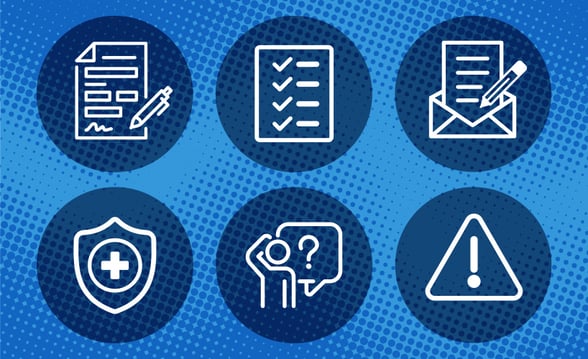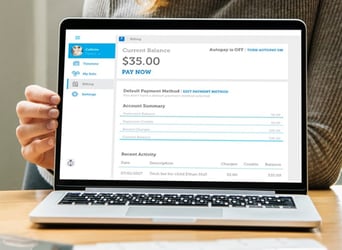
These programs aren’t just about filling time! They’re about keeping kids safe, engaged and supported when school isn’t in session. Managing childcare schedules across schools, ages and pickup times is as fun as it sounds.
However, here’s the thing: wraparound care matters. It matters to working parents, it matters to kids and it matters to you — the person holding it all together. This guide is designed to help you navigate the reality of daily logistics without fluff or sugarcoating.
Table of Contents
- Key Responsibilities in Managing Before- and After-School Care
- Best Practices for Daily Operations
- Activity Planning for Before and After School Hours
- Communication and Collaboration with Parents & Schools
- Budgeting and Managing Payments
- How Vanco Supports Before and After-School Programs
- FAQs
- Conclusion
- 100+ Free Templates for After School Programs
Key Responsibilities in Managing Before- and After-School Care

Coordinating Schedules Across Age Groups and Schools
You’ve got kids arriving at different times, from various schools and across multiple age groups. Timing is everything. Getting a group of second graders from the local elementary school while the older kids are finishing their homework can feel like orchestrating a symphony with no conductor.
But you’re doing it. Coordinating schedules across age groups and schools requires finesse, and a good tool like the ACT Now Illinois Toolkit can help streamline important things like:
- Transportation
- Activity times
- Snack schedules
It’s a lot to manage, but your cool-headed approach makes it look easy.
Staffing and Supervision During Early Morning and Late Afternoon Hours
Mornings and late afternoons are the peak times of day for chaos, and you’re right in the middle of it. Kids are tired, parents are rushing and everyone wants to get through the day without major meltdowns.
Staffing and supervision during these hours are crucial. The right staff makes all the difference in how smoothly the program runs, and you're working hard to meet the staff-to-child ratios mandated by Illinois DCFS. However, it’s not just about numbers. It’s about keeping kids engaged, safe and entertained.
Training matters, too, whether it's keeping everyone on task during an arts and crafts project or managing a last-minute meltdown over a missing jacket. The best practices for school-age care always involve a well-prepared team.
Creating a Safe, Welcoming Environment for Students
Most of the job is about creating a space where kids feel comfortable, safe, seen and ready to learn or play. Whether you’re running through the before-school care routines or supervising aftercare activities for kids, your job is more than just filling time.
You’re setting up an environment where every child can relax, even if their day hasn’t been perfect. You’ll need clear expectations and a routine that helps them feel grounded, no matter the chaos outside the room.
Getting the atmosphere right isn’t always easy, but when the kids start smiling and engaging, you know you’ve done it right.
Best Practices for Daily Operations
Scheduling and Routines
Running this kind of school program needs some before-and-after-school program tips for childcare scheduling. You want kids to have fun, but you also want to keep things structured enough so chaos doesn’t take over. The key here is scheduling.
Set up routines that cover everything from arrival and snack time to activities and pickup and stick to them. Kids thrive when they know what comes next; it gives them a sense of control over their day.
You’ll find that when they know snack time is at 3:30 p.m., they start looking forward to it, and when the activities follow soon after, the day moves smoothly. But childcare scheduling isn’t just about filling up time slots. These routines are critical for children’s social and emotional health. A structured day lets kids focus on their work and play without the anxiety of not knowing what’s coming next.
They feel safer, and that’s half the battle when managing school-age childcare programs.
Staff Planning and Training
Staffing can be a juggling act, especially when you’ve got kids of all ages in the same room. You can’t just throw a few people together and hope for the best. Staff planning and training are the backbone of any successful program.
Ideally, you’re working with staff members who know the importance of maintaining a safe, engaging and nurturing environment. A strong child-to-staff ratio is key here. Too many kids and not enough staff can quickly make things go sideways.
The NAEYC has guidelines that can help you strike the right balance between keeping everyone safe and ensuring every child gets the attention they deserve.
But ratios are just the beginning. The real magic happens when your staff is adequately trained, not just in the essentials like first aid and CPR, but also in communication. Having staff members who are skilled at managing group dynamics, handling kids with different needs and responding to parents’ questions makes all the difference.
Safety, Check-In and Dismissal Protocols
This is one of the best practices for school-age care you can't ignore. When you’re in charge of kids, safety is always at the top of your mind. One of the most crucial aspects of managing before-and after-school care is ensuring you have proper check-in and dismissal protocols in place.
You need a system that tracks who’s coming at all times. A solid sign-in/out system is an absolute must. Make sure it’s simple and easy for parents and staff alike to use, but secure enough that no one gets in or out without proper authorization.
Speaking of pickups, let’s talk about who’s allowed to take the kids home. It’s not just about who shows up; it’s about ensuring the right people are taking the kids. Authorized pickup procedures must be tight, clear and effective.
Parents need to trust that their children are only going home with someone they’ve specifically designated. The last thing you want is confusion at the end of the day.
The more you invest in these details, the more you create an environment where kids can feel safe, have fun, and, most importantly, grow.
Activity Planning for Before and After School Hours
Quiet Morning Activities
Mornings before school are a mixed bag. Some kids wake up ready to take on the world, while others are still figuring out how to open their eyes. That’s why quiet activities like reading corners, journaling and puzzles work so well.
They set the tone for a calm and productive day. Think about it. A kid who starts the day immersed in a book or quietly solving a puzzle is more likely to ease into their school day than one immediately thrown into chaos.
For your program, this is about creating that balance between structure and flexibility. It’s a perfect example of before-school care routines that offer just the right amount of quiet time without making the morning feel like a long wait for the bus.
Enrichment and Homework Help
When school’s out and you’ve got kids bouncing off the walls, it might seem impossible to get them to focus on anything, let alone homework. However, here’s the thing: academic support doesn’t need to feel like a chore.
It can be an enriching part of the day. Providing homework help and tutoring sessions doesn’t have to be a battle. Think of it as the calm after the storm; kids decompress after a day of school while still staying on track with their studies.
You must find a way to mix fun with learning. Kids don’t want to feel like they’re stuck in a classroom again, but offering an environment where they can get a little help with math or reading while also having room for free play keeps everyone happy.
With the right school-age childcare management approach, you can ensure that kids are getting the educational support they need without it feeling like “homework jail.”
Active Play and Outdoor Time
Now, let’s talk about the part of the day where you get to step back, let the kids burn off some energy and maybe even catch a breath yourself. Active play is essential.
Kids need to move, and if you keep them inside too long, you end up with a group of rowdy kids on your hands. Whether it’s structured games, a friendly race or simply some free time in the yard, outdoor activities are necessary.
The best part? These outdoor moments don’t just keep kids active; they also provide much-needed social time where they can:
- Bond with peers
- Develop teamwork skills
- Develop interpersonal skills
It’s all part of the learning process. Balancing these moments with other, more structured activities creates a dynamic, well-rounded day in your extended-day program operations.
Arts and Creative Exploration
It’s not just about making something pretty; it’s about building confidence and encouraging creativity. You might find that the quietest kids open up during an art project, or the most energetic ones become focused when they get their hands on some paint.
Craft, music, group art, and science, technology, engineering and math (STEM) projects can all be part of your activity schedule.
Integrating arts and creative exploration into your program gives kids the freedom to be themselves, and it’s fun for you too. You’ll see their excitement when they finish a project, and you might even be surprised by how much they learn without even realizing it. Ultimately, this can help them with preschool to school-age transition support.
Communication and Collaboration with Parents & Schools
Providing Consistent Updates and Newsletters
If you’ve ever had a parent ask what their kid did all afternoon and you couldn’t quite say, you already know how vital communication is. Before- and after-school care isn’t just “holding space” for kids. It’s where they spend hours learning, playing, snacking and possibly debating who gets the red marker next.
Parent communication in wraparound care is essential. Parents want to be in the loop. A weekly update (even a short one) goes a long way toward building trust. Don’t overthink it. A few photos, a snack menu, maybe a note that “Monday’s game of freeze tag got intense,” and you’re set.
Yes, newsletters may feel old-school, but they still work, especially when juggling multiple age groups, managing various classrooms and trying to remember which child brought a hermit crab for show-and-tell.
Newsletters give you space to share upcoming events, policy reminders and a quick peek into daily aftercare activities for kids. It’s also a good excuse to clarify any changes in school-age childcare management before parents start emailing you at 10 p.m.
Coordinating Schedules with School Calendars and Transportation
Here’s where things can get messy. Coordinating with schools means you’re dealing with bell schedules, teacher workdays and surprise assemblies that suddenly shift dismissal times.
When you’re running wraparound care, your job is to plug into all of it without dropping the ball. If you’ve ever had to track down a kid who’s unexpectedly on a choir field trip while a parent is waiting, you know.
You also have to think about the buses. If you're not in regular contact with school transportation, you’re essentially guessing every day. That’s not a great plan when you're managing daily childcare logistics or trying to run smooth extended-day program operations.
Collecting Feedback and Adjusting Services as Needed
As much as we’d all like to think we’re doing everything right, sometimes a parent’s offhand comment about snack choices reveals more than a staff meeting ever could. Feedback matters. It’s how you find out that older kids feel bored after 4 p.m. or that a parent didn’t realize you offered before-school care routines at all.
Create space for that feedback. Make it easy by providing:
- QR codes on sign-out sheets
- Short monthly surveys
- Quick chats during pickup
Be sure you act on feedback. When parents see changes in how you handle managing childcare schedules or tweak your programming based on suggestions, they feel like partners, not customers.
That sense of partnership is what makes your school-age childcare program stand out. It’s not about being perfect. It’s about being adaptable, transparent and just organized enough that everything looks like it runs smoothly, even on the days it definitely doesn’t.
Budgeting and Managing Payments
Estimating Costs for Staffing, Snacks and Supplies
You already know that the real cost of before- and after-school care isn't just about crayons and juice boxes. When you're deep into school-age childcare management, you see how the hours between 6 a.m. and 6 p.m. can add up fast.
Staffing alone can account for a considerable amount of your budget, and that’s before you’ve stocked up on snacks or craft supplies. According to the NAEYC, rent and utilities can account for 32% of expenses.
Also, if you run an extended-day program, you’re probably managing multiple locations, age groups and transportation costs.
The Wallace Foundation’s Cost Calculator has saved many teams countless hours of spreadsheet chaos. It helps you break down every line item, especially when navigating licensing for before- and after-school programs.
Setting Tuition Rates and Payment Schedules
Tuition is where it gets tricky. You’re trying to strike a balance, keeping your affordable after-school programming accessible while ensuring your team gets paid. It’s not just about setting a number, it’s about flexibility.
With different pickup times, full-day options and wraparound care, you need a plan that adjusts for every situation. Families appreciate clear payment schedules and so will you.
Using Vanco for Tuition Collection
Stop chasing paper checks! With Vanco’s billing platform, streamlining childcare billing through automated payments, digital invoicing and a parent portal that works every time becomes easy.
Whether you’re managing daily childcare logistics or trying to streamline childcare billing, Vanco gives you room to breathe. Parents set up recurring payments and you track fees in real time — no more surprises.
How Vanco Supports Before- and After-School Programs

As a manager, you’re not just running aftercare activities for kids; you’re managing a whole operation. Vanco simplifies fee tracking, registration and communication so you can focus on creating the kind of before- and after-school care routines that matter.
Our platform supports everything from parent communication in wraparound care to managing preschool to school-age transition support. See what Vanco can do for your program.
FAQs
What is the ideal schedule for before- and after-school care?
You’ll usually run from 6 a.m. to 6 p.m. That gives families flexibility while keeping before-school care routines and aftercare activities for kids consistent.
How many staff members do I need for a mixed age group?
Your school-age childcare management hinges on proper ratios. Licensing for before- and after-school program standards varies, so always align with state guidelines for extended-day childcare operations.
What are some low-cost activity ideas for extended daycare?
Think puzzles, journaling and group games. Simple aftercare activities for kids build connections without draining your budget.
How can I communicate effectively with busy parents?
Use daily updates, visual boards and texts. Parent communication in wraparound care builds trust.
What’s the best way to manage tuition payments and fees?
Automated billing can help streamline childcare billing, scheduling and tuition collection.
Conclusion
The backbone of great wraparound care is smart coordination, consistent before-school care routines, flexible extended-day program operations and thoughtful aftercare activities for kids.
Managing daily childcare logistics takes more than patience; it takes structure. From setting tuition to improving parent communication in wraparound care, every detail matters.
Want tools that help you stay organized, compliant and financially sound? Vanco is here for you.
100+ Free Afterschool Program Templates to Save Time & Money
We know daycare providers like yourself are busy. That's why we made dozens of templates to help you manage the various aspects of your organization. From billing and invoicing to marketing materials, we have it all. Download all 100+ today!
Get the Full Collection with Just 4 Simple Steps: Assembly Required (0 Minutes)
Step 1: Click button
Step 2: Download 100+ ready-to-use templates
Step 3: Implement immediately
Step 4: Experience efficient childcare management












